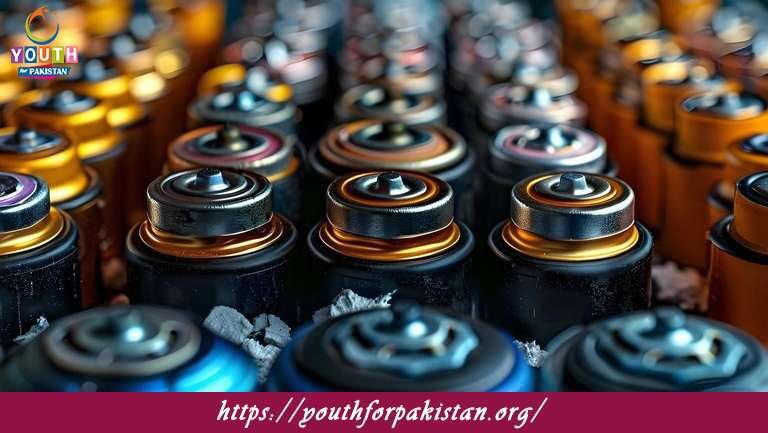9th Class Chemistry Chapter 7 MCQs with Answers

Get a tight grip over Electrochemistry with engaging 9th Class Chemistry Chapter 7 MCQs. The questions engage in processes concerning electrolysis, redox reactions, and electrochemical cells. Just the right thing to master the chapter, this post also throws into a limelight trending keywords like electrochemistry quiz and electrolysis MCQs for better learning. Detailed answers and explanations are provided to clear all doubts. Enhance your exam preparations through this resourceful post.
What is the branch of chemistry that deals with the study of the relationship between electricity and chemical reactions?
a) Organic chemistry
b) Inorganic chemistry
c) Physical chemistry
d) Electrochemistry
What is the SI unit of electric charge?
a) Ampere
b) Coulomb
c) Volt
d) Ohm
The process of converting chemical energy into electrical energy in an electrochemical cell is called:
a) Electroplating
b) Electrolysis
c) Electrodeposition
d) Galvanic cell
Which of the following is an example of a non-spontaneous electrochemical reaction?
a) Charging a battery
b) Discharging a battery
c) Rusting of iron
d) Electroplating of silver
In an electrochemical cell, where does oxidation occur?
a) Cathode
b) Anode
c) Salt bridge
d) Electrolyte
What is the process of using an electric current to drive a non-spontaneous chemical reaction?
a) Electrolysis
b) Galvanization
c) Electroplating
d) Electromagnetism
In an electrochemical cell, what is the function of the salt bridge?
a) To connect the anode and cathode
b) To prevent the mixing of electrolytes
c) To complete the circuit
d) To regulate the flow of current
Which of the following statements is true about a cathode in an electrochemical cell?
a) It is the site of oxidation
b) It is the site of reduction
c) It has a negative charge
d) It releases electrons to the external circuit
What is the standard potential of the hydrogen electrode used as a reference in electrochemical measurements?
a) -1.23 V
b) 0 V
c) +0.34 V
d) +1.00 V
What is the process of coating an object with a layer of metal using electrolysis?
a) Electrolysis
b) Galvanization
c) Electroplating
d) Electromagnetism
Which type of electrochemical cell can be used to measure the standard electrode potential of an element?
a) Galvanic cell
b) Electrolytic cell
c) Concentration cell
d) Fuel cell
What is the process of using electrical energy to drive a redox reaction that is non- spontaneous?
a) Electrolysis
b) Galvanization
c) Electroplating
d) Electromagnetism
In an electrochemical cell, which electrode is connected to the positive terminal of the external circuit?
a) Anode
b) Cathode
c) Salt bridge
d) Electrolyte
Which of the following is an example of a spontaneous electrochemical reaction?
a) Charging a battery
b) Discharging a battery
c) Electroplating of silver
d) Electrolysis of water
What is the standard potential of the standard hydrogen electrode (SHE)?
a) 0 V
b) -1.23 V
c) +0.34 V
d) +1.00 V
In an electrochemical cell, what is the function of the salt bridge?
a) To connect the anode and cathode
b) To prevent the mixing of electrolytes
c) To complete the circuit
d) To regulate the flow of current
Which of the following statements is true about a cathode in an electrochemical cell?
a) It is the site of oxidation
b) It is the site of reduction
c) It has a negative charge
d) It releases electrons to the external circuit
What is the standard potential of the hydrogen electrode used as a reference in electrochemical measurements?
a) -1.23 V
b) 0 V
c) +0.34 V
d) +1.00 V
What is the process of coating an object with a layer of metal using electrolysis?
a) Electrolysis
b) Galvanization
c) Electroplating
d) Electromagnetism
Which type of electrochemical cell can be used to measure the standard electrode potential of an element?
a) Galvanic cell
b) Electrolytic cell
c) Concentration cell
d) Fuel cell
What is the process of using electrical energy to drive a redox reaction that is non- spontaneous?
a) Electrolysis
b) Galvanization
c) Electroplating
d) Electromagnetism
In an electrochemical cell, which electrode is connected to the positive terminal of the external circuit?
a) Anode
b) Cathode
c) Salt bridge
d) Electrolyte
Which of the following is an example of a spontaneous electrochemical reaction?
a) Charging a battery
b) Discharging a battery
c) Electroplating of silver
d) Electrolysis of water
What is the standard potential of the standard hydrogen electrode (SHE)?
a) 0 V
b) -1.23 V
c) +0.34 V
d) +1.00 V
Which of the following is an example of a spontaneous electrochemical reaction?
a) Charging a battery
b) Discharging a battery
c) Electroplating of silver
d) Electrolysis of water
What is the standard potential of the standard hydrogen electrode (SHE)?
a) 0 V
b) -1.23 V
c) +0.34 V
d) +1.00 V
In an electrochemical cell, where does oxidation occur?
a) Cathode
b) Anode
c) Salt bridge
d) Electrolyte
What is the process of using an electric current to drive a non-spontaneous chemical reaction?
a) Electrolysis
b) Galvanization
c) Electroplating
d) Electromagnetism
In an electrochemical cell, what is the function of the salt bridge?
a) To connect the anode and cathode
b) To prevent the mixing of electrolytes
c) To complete the circuit
d) To regulate the flow of current
Which of the following statements is true about a cathode in an electrochemical cell?
a) It is the site of oxidation
b) It is the site of reduction
c) It has a negative charge
d) It releases electrons to the external circuit
What is the standard potential of the hydrogen electrode used as a reference in electrochemical measurements?
a) -1.23 V
b) 0 V
c) +0.34 V
d) +1.00 V
What is the process of coating an object with a layer of metal using electrolysis?
a) Electrolysis
b) Galvanization
c) Electroplating
d) Electromagnetism
Which type of electrochemical cell can be used to measure the standard electrode potential of an element?
a) Galvanic cell
b) Electrolytic cell
c) Concentration cell
d) Fuel cell
What is the process of using electrical energy to drive a redox reaction that is non- spontaneous?
a) Electrolysis
b) Galvanization
c) Electroplating
d) Electromagnetism
In an electrochemical cell, which electrode is connected to the positive terminal of the external circuit?
a) Anode
b) Cathode
c) Salt bridge
d) Electrolyte
Which of the following is an example of a spontaneous electrochemical reaction?
a) Charging a battery
b) Discharging a battery
c) Electroplating of silver
d) Electrolysis of water
What is the standard potential of the standard hydrogen electrode (SHE)?
a) 0 V
b) -1.23 V
c) +0.34 V
d) +1.00 V
In an electrochemical cell, where does oxidation occur?
a) Cathode
b) Anode
c) Salt bridge
d) Electrolyte
What is the process of using an electric current to drive a non-spontaneous chemical reaction?
a) Electrolysis
b) Galvanization
c) Electroplating
d) Electromagnetism
In an electrochemical cell, what is the function of the salt bridge?
a) To connect the anode and cathode
b) To prevent the mixing of electrolytes
c) To complete the circuit
d) To regulate the flow of current
Which of the following statements is true about a cathode in an electrochemical cell?
a) It is the site of oxidation
b) It is the site of reduction
c) It has a negative charge
d) It releases electrons to the external circuit
What is the standard potential of the hydrogen electrode used as a reference in electrochemical measurements?
a) -1.23 V
b) 0 V
c) +0.34 V
d) +1.00 V
What is the process of coating an object with a layer of metal using electrolysis?
a) Electrolysis
b) Galvanization
c) Electroplating
d) Electromagnetism
Which type of electrochemical cell can be used to measure the standard electrode potential of an element?
a) Galvanic cell
b) Electrolytic cell
c) Concentration cell
d) Fuel cell
What is the process of using electrical energy to drive a redox reaction that is non- spontaneous?
a) Electrolysis
b) Galvanization
c) Electroplating
d) Electromagnetism
In an electrochemical cell, which electrode is connected to the positive terminal of the external circuit?
a) Anode
b) Cathode
c) Salt bridge
d) Electrolyte
Which of the following is an example of a spontaneous electrochemical reaction?
a) Charging a battery
b) Discharging a battery
c) Electroplating of silver
d) Electrolysis of water
What is the standard potential of the standard hydrogen electrode (SHE)?
a) 0 V
b) -1.23 V
c) +0.34 V
d) +1.00 V
In an electrochemical cell, where does oxidation occur?
a) Cathode
b) Anode
c) Salt bridge
d) Electrolyte
What is the process of using an electric current to drive a non-spontaneous chemical reaction?
a) Electrolysis
b) Galvanization
c) Electroplating
d) Electromagnetism
In an electrochemical cell, what is the function of the salt bridge?
a) To connect the anode and cathode
b) To prevent the mixing of electrolytes
c) To complete the circuit
d) To regulate the flow of current
Which of the following statements is true about a cathode in an electrochemical cell?
a) It is the site of oxidation
b) It is the site of reduction
c) It has a negative charge
d) It releases electrons to the external circuit
What is the standard potential of the hydrogen electrode used as a reference in electrochemical measurements?
a) -1.23 V
b) 0 V
c) +0.34 V
d) +1.00 V
What is the process of coating an object with a layer of metal using electrolysis?
a) Electrolysis
b) Galvanization
c) Electroplating
d) Electromagnetism
Which type of electrochemical cell can be used to measure the standard electrode potential of an element?
a) Galvanic cell
b) Electrolytic cell
c) Concentration cell
d) Fuel cell
What is the process of using electrical energy to drive a redox reaction that is non- spontaneous?
a) Electrolysis
b) Galvanization
c) Electroplating
d) Electromagnetism
In an electrochemical cell, which electrode is connected to the positive terminal of the external circuit?
a) Anode
b) Cathode
c) Salt bridge
d) Electrolyte
Which of the following is an example of a spontaneous electrochemical reaction?
a) Charging a battery
b) Discharging a battery
c) Electroplating of silver
d) Electrolysis of water
What is the standard potential of the standard hydrogen electrode (SHE)?
a) 0 V
b) -1.23 V
c) +0.34 V
d) +1.00 V
In an electrochemical cell, where does oxidation occur?
a) Cathode
b) Anode
c) Salt bridge
d) Electrolyte
If you are interested to enhance your knowledge regarding Physics, Chemistry, Biology, and Computer please click on the link of each category, you will be redirected to dedicated website for each category.





